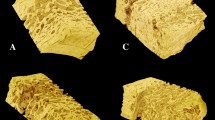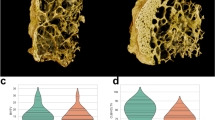Abstract
Hyperostosis frontalis interna (HFI) is a condition characterized by abnormal bone outgrowth on the inner surface of the frontal bone. Most HFI cases occur in post-menopausal elderly women. The pathology of HFI development is uncertain. The estimated incidence of HFI ranges from 5 to 12% in Western countries, but few cases have been reported in the Japanese population. Here, we report a case of HFI in an 86-year-old Japanese female cadaver. Macroscopically, the internal surface of the frontal bone exhibited bilateral nodular protrusion with sparing of the midline, while the external surface was normal. According to the morphological classification of HFI proposed by Hershkovitz et al. this case belongs to type D, the most severe type. Using computed tomography (CT), we defined five layers, designated as I–V from the inner to the outer layer, in the nodular region of HFI; however, the normal frontal bone is composed of three layers. Histological results demonstrated that layers I, III, and V consisted of the cortical bone, and layers II and IV consisted of the trabecular bone. We also observed increases in the numbers of lamellar bone and blood vessels on the dural side of layer I, indicating increased vascularization and active osteogenesis. These results indicate that layer II represents a new diploe within the inner table, which split into layers I and III, suggesting that diploization within the inner table by activated remodeling may be involved in the development of hyperostosis in this case.

Similar content being viewed by others
References
Bracanovic D, Djonic D, Nikolic S et al (2016) 3D-Microarchitectural patterns of hyperostosis frontalis interna: a micro-computed tomography study in aged women. J Anat 229:673–680
Glinskii OV, Abraha TW, Turk JR, Rubin LJ, Huxley VH, Glinsky VV (2007) Microvascular network remodeling in dura mater of ovariectomized pigs: role for angiopoietin-1 in estrogen-dependent control of vascular stability. Am J Physiol Heart Circ Physiol 293:H1131–1137
Hershkovitz I, Greenwald C, Rothschild BM et al (1999) Hyperostosis frontalis interna: an anthropological perspective. Am J Phys Anthropol 109:303–325
Hu K, Olsen BR (2016) The roles of vascular endothelial growth factor in bone repair and regeneration. Bone 91:30–38
Ishiguro M, Nakagawa T, Yamamura N, Kurokawa Y (1997) Japanese cases of hyperostosis frontalis interna. No To Shinkei 49:899–904
Kusumbe AP, Ramasamy SK, Adams RH (2014) Coupling of angiogenesis and osteogenesis by a specific vessel subtype in bone. Nature 507:323–328
May H, Peled N, Dar G, Abbas J, Hershkovitz I (2011) Hyperostosis frontalis interna: what does it tell us about our health? Am J Hum Biol 23:392–397
Moore S (1955) Hyperostosis cranii. Charles C. Thomas, Springfield
Szeniczey T, Marcsik A, Ács Z, Balassa T et al (2019) Hyperostosis frontalis interna in ancient populations from the Carpathian Basin: a possible relationship between lifestyle and risk of development. Int J Paleopathol 24:108–118
Acknowledgements
We thank Editage (www.editage.com) for the English language editing of our paper.
Funding
This research received no funding.
Author information
Authors and Affiliations
Contributions
KM and AN conducted the dissections. AN and YI designed the anatomical investigations. KM, AN, MN, AT, and YI contributed to the data acquisition and analysis. YI wrote the manuscript. All authors read and approved the final manuscript.
Corresponding author
Ethics declarations
Conflict of interest
The authors declare that they have no conflicts of interest.
Additional information
Publisher's Note
Springer Nature remains neutral with regard to jurisdictional claims in published maps and institutional affiliations.
Rights and permissions
About this article
Cite this article
Morita, K., Nagai, A., Naitoh, M. et al. A rare case of hyperostosis frontalis interna in an 86-year-old Japanese female cadaver. Anat Sci Int 96, 315–318 (2021). https://doi.org/10.1007/s12565-020-00577-5
Received:
Accepted:
Published:
Issue Date:
DOI: https://doi.org/10.1007/s12565-020-00577-5




